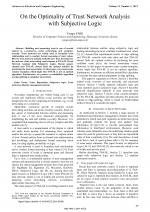| 3/2014 - 6 |
On the Optimality of Trust Network Analysis with Subjective LogicPARK, Y. |
| Extra paper information in |
| Click to see author's profile in |
| Download PDF |
Author keywords
trust, reputation, subjective logic, trust networks, identity management system
References keywords
trust(12), networks(6), josang(5), optimization(4), management(4), computing(4)
Blue keywords are present in both the references section and the paper title.
About this article
Date of Publication: 2014-08-31
Volume 14, Issue 3, Year 2014, On page(s): 49 - 54
ISSN: 1582-7445, e-ISSN: 1844-7600
Digital Object Identifier: 10.4316/AECE.2014.03006
Web of Science Accession Number: 000340869800006
SCOPUS ID: 84907335535
Abstract
Building and measuring trust is one of crucial aspects in e-commerce, social networking and computer security. Trust networks are widely used to formalize trust relationships and to conduct formal reasoning of trust values. Diverse trust network analysis methods have been developed so far and one of the most widely used schemes is TNA-SL (Trust Network Analysis with Subjective Logic). Recent papers claimed that TNA-SL always finds the optimal solution by producing the least uncertainty. In this paper, we present some counter-examples, which imply that TNA-SL is not an optimal algorithm. Furthermore, we present a probabilistic algorithm in edge splitting to minimize uncertainty. |
| References | | | Cited By |
Web of Science® Times Cited: 3 [View]
View record in Web of Science® [View]
View Related Records® [View]
Updated 2 weeks, 5 days ago
SCOPUS® Times Cited: 2
View record in SCOPUS® [Free preview]
View citations in SCOPUS® [Free preview]
[1] Structural Dimensions and Measurement of Trust Networks among Construction Project Participants, Wang, Xiang, Yin, Yilin, Sustainability, ISSN 2071-1050, Issue 5, Volume 15, 2023.
Digital Object Identifier: 10.3390/su15054112 [CrossRef]
Disclaimer: All information displayed above was retrieved by using remote connections to respective databases. For the best user experience, we update all data by using background processes, and use caches in order to reduce the load on the servers we retrieve the information from. As we have no control on the availability of the database servers and sometimes the Internet connectivity may be affected, we do not guarantee the information is correct or complete. For the most accurate data, please always consult the database sites directly. Some external links require authentication or an institutional subscription.
Web of Science® is a registered trademark of Clarivate Analytics, Scopus® is a registered trademark of Elsevier B.V., other product names, company names, brand names, trademarks and logos are the property of their respective owners.
Faculty of Electrical Engineering and Computer Science
Stefan cel Mare University of Suceava, Romania
All rights reserved: Advances in Electrical and Computer Engineering is a registered trademark of the Stefan cel Mare University of Suceava. No part of this publication may be reproduced, stored in a retrieval system, photocopied, recorded or archived, without the written permission from the Editor. When authors submit their papers for publication, they agree that the copyright for their article be transferred to the Faculty of Electrical Engineering and Computer Science, Stefan cel Mare University of Suceava, Romania, if and only if the articles are accepted for publication. The copyright covers the exclusive rights to reproduce and distribute the article, including reprints and translations.
Permission for other use: The copyright owner's consent does not extend to copying for general distribution, for promotion, for creating new works, or for resale. Specific written permission must be obtained from the Editor for such copying. Direct linking to files hosted on this website is strictly prohibited.
Disclaimer: Whilst every effort is made by the publishers and editorial board to see that no inaccurate or misleading data, opinions or statements appear in this journal, they wish to make it clear that all information and opinions formulated in the articles, as well as linguistic accuracy, are the sole responsibility of the author.



